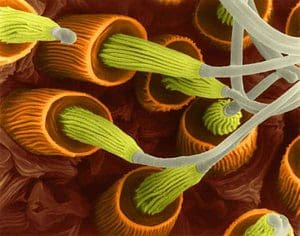
In a mind boggling act, spiders are capable of “ballooning” themselves using silk strands and fly for miles, both in altitude and distance. Small and big spiders alike can do this, although smaller ones are capable of traveling further, and scientists have long theorized the mechanisms of spider ‘flight’. Peter Gorham at the University of Hawaii tested a theory that dates back from the early 1800s, first proposed by Charles Darwin himself, which states that the spiders achieve their amazing lift through electrostatic means. His findings support this theory, explaining the mysterious and peculiar spider flight behavior which has puzzled scientists for so long.
While off the cost of Argentina a few tens of miles away sailing in the infamous HMS Beagle in the 1830s, Darwin perplexedly recalled how the ship was flooded with spiders as if they had dropped from the clouds.
“I repeatedly observed the same kind of small spider, either when placed or having crawled on some little eminence, elevate its abdomen, send forth a thread, and then sail away horizontally, but with a rapidity which was quite unaccountable.” C. Darwin.
At the time Darwin thought spiders used their silk to catch thermal air currents to carry them to considerable height, and this conventional wisdom was used to explain it for years. Darwin also proposed “electrostatic repulsion” played a role in the fanning of the threads, but this theory was dismissed by biologists in favor of the thermal air currents theory.
Launching spiders several miles up high
Hot air doesn’t account for a number of anomalies, however. How can these spiders launch themselves with a surprisingly high velocity even when there is little or no wind; how do thermal currents lift heavy adult spiders of up to 100 milligrams; and when spiders release several threads, why do these threads form a fan-shape as if repelling each other?
Gorham re-examined the electrostatic theory and says that it can easily account for all the mysterious flying behaviours of ballooning spiders. He first explored the idea by find out how much charge a strand must have to lift a spider of a certain weight. This turns out to range from 10 to 30 nanoCoulombs. Spider silk contains certain charge bearing amino acids and becomes negatively charged when put in contact with other materials. In theory, then, spider silk could become charge right from its release as it leaves the spinnerets, through a process known as flow electrification.
“There are thus a wide and plausible range of processes by which the strands can acquire initial charge,” Gorham writes.
As for the origin of this charge, Gorham believes the Earth itself could offer the necessary kick. The Earth has as a negative charge density of about 6 nanoCoulombs per square metre on average or more than enough give spider silk the necessary boost. All this explains the spider’s launch power in still air, why large spiders can get such a lift and why the silk strands fan out: “because their negative charges repel.”
via Nat Geographic


